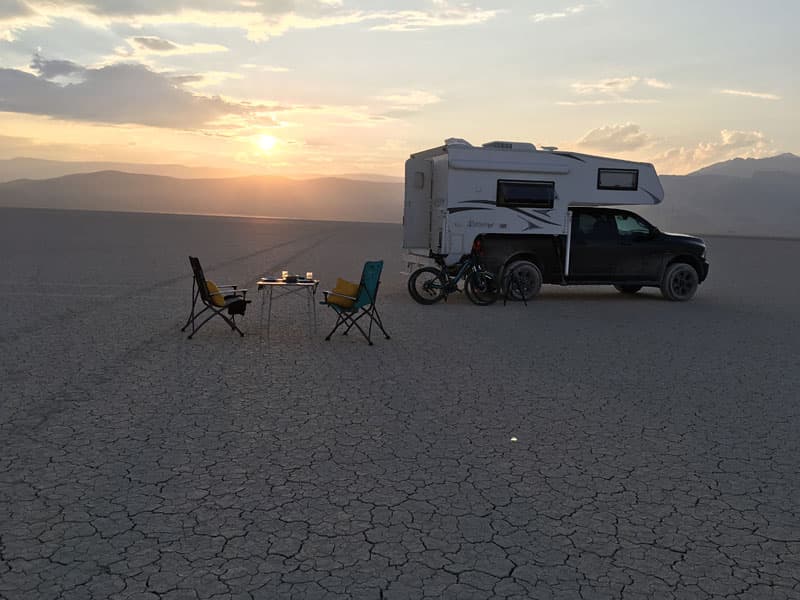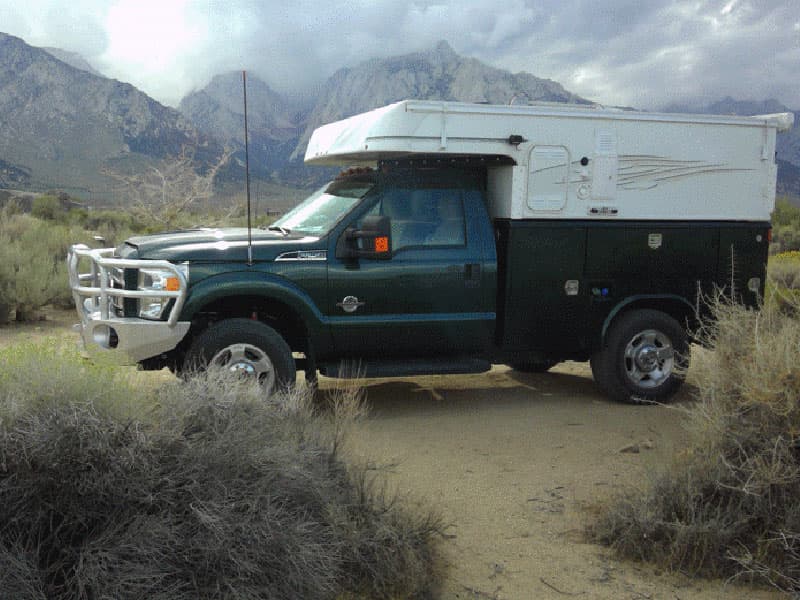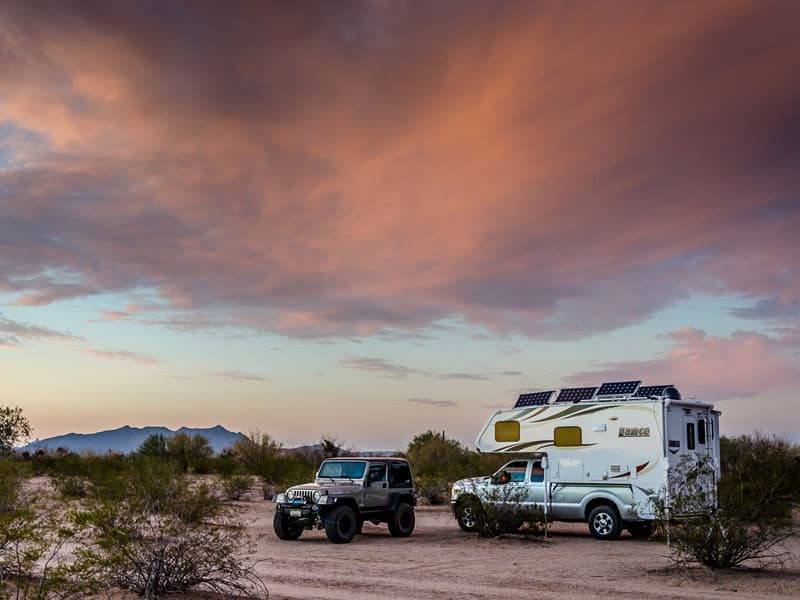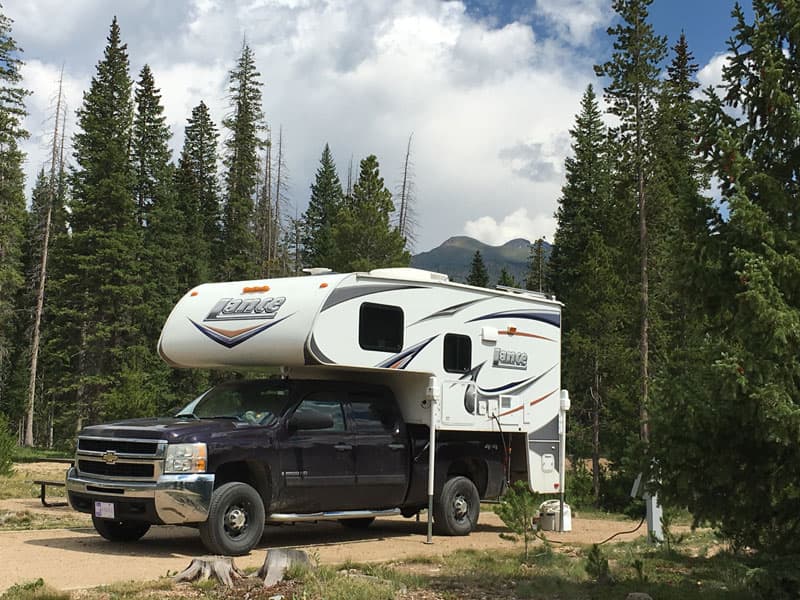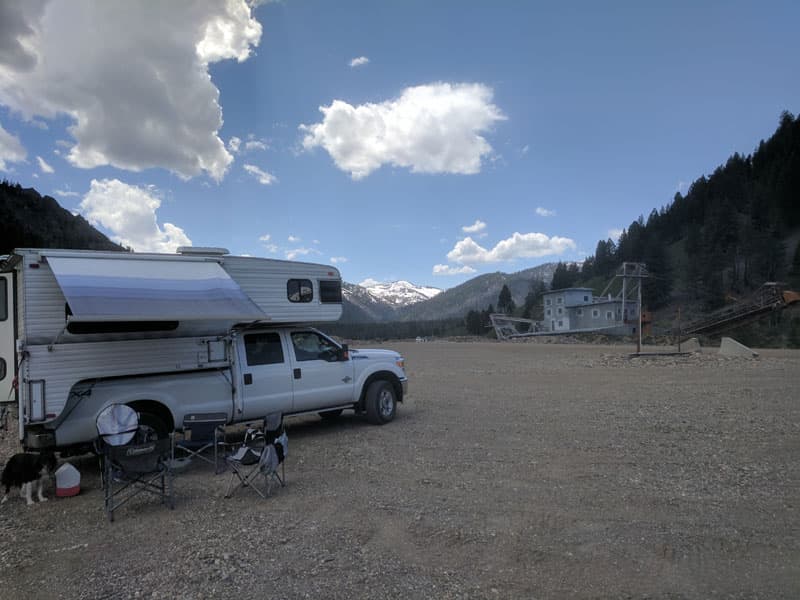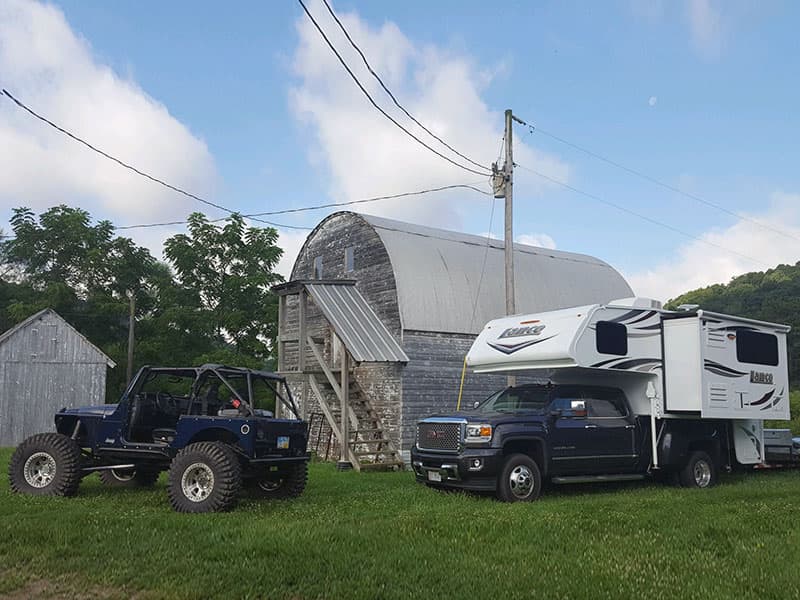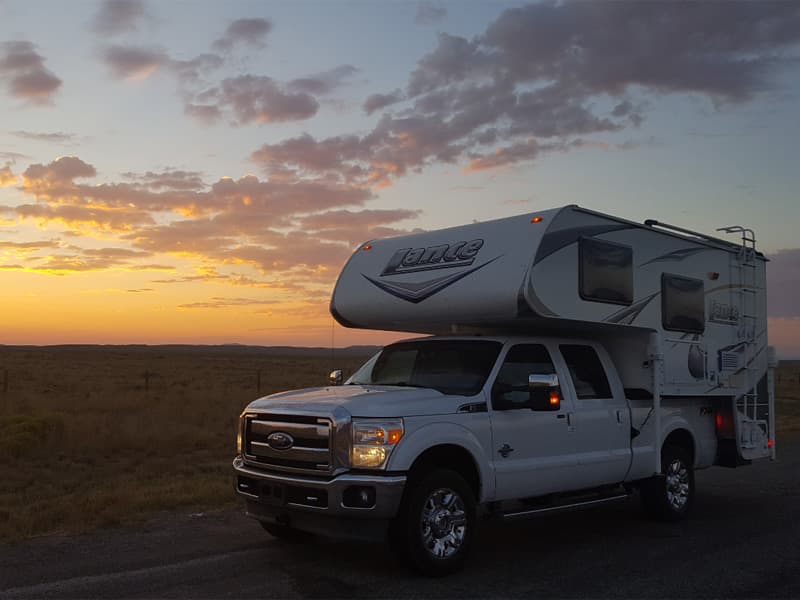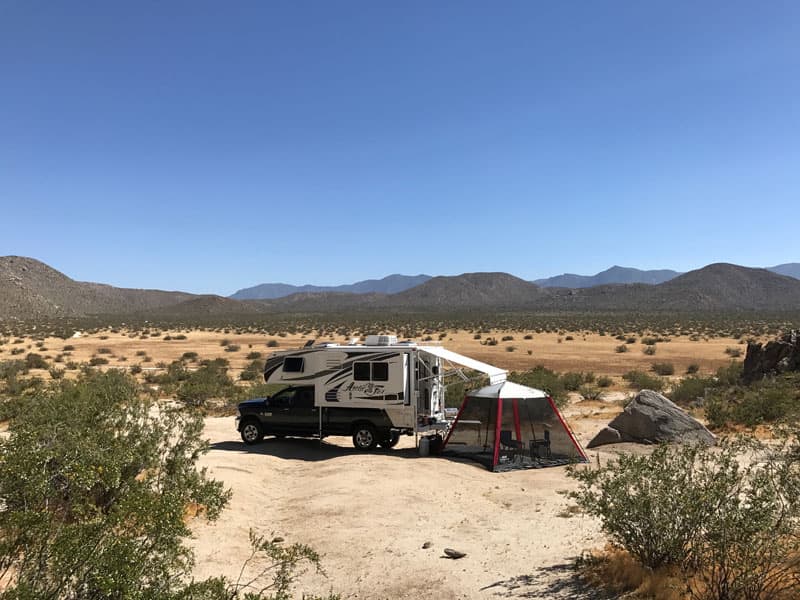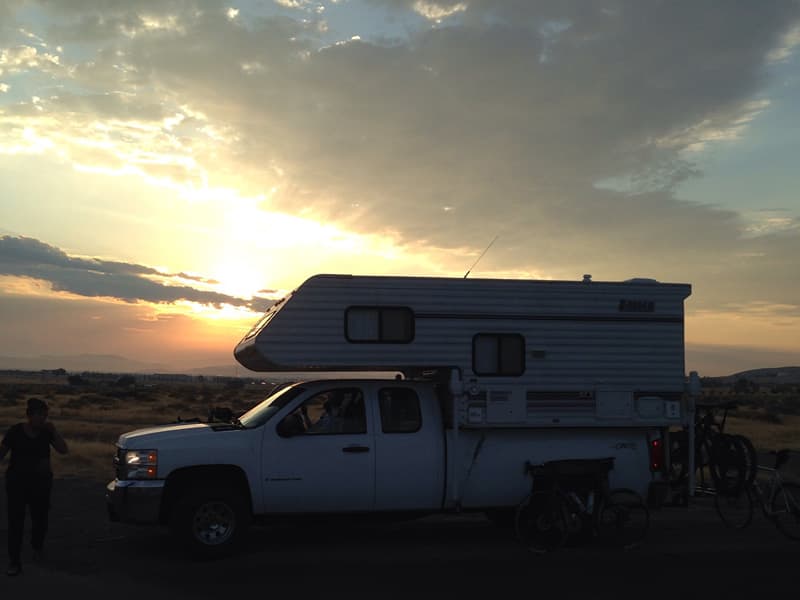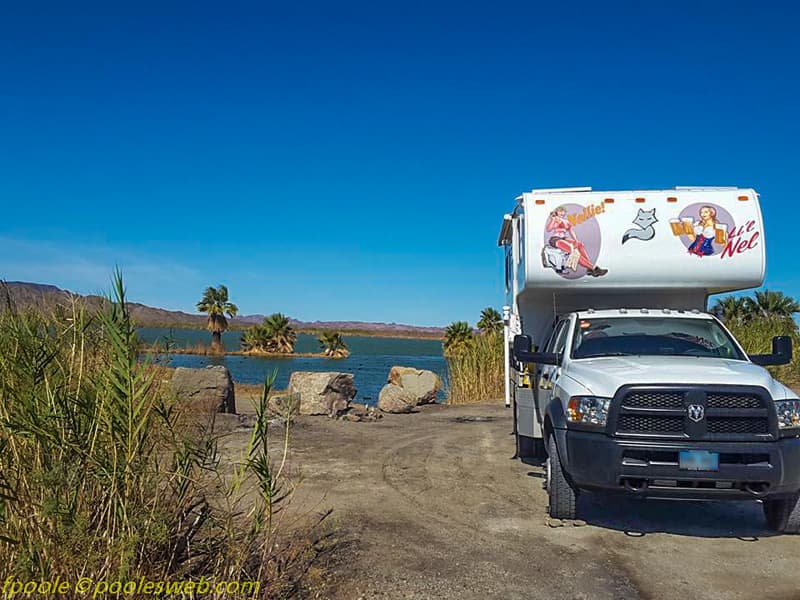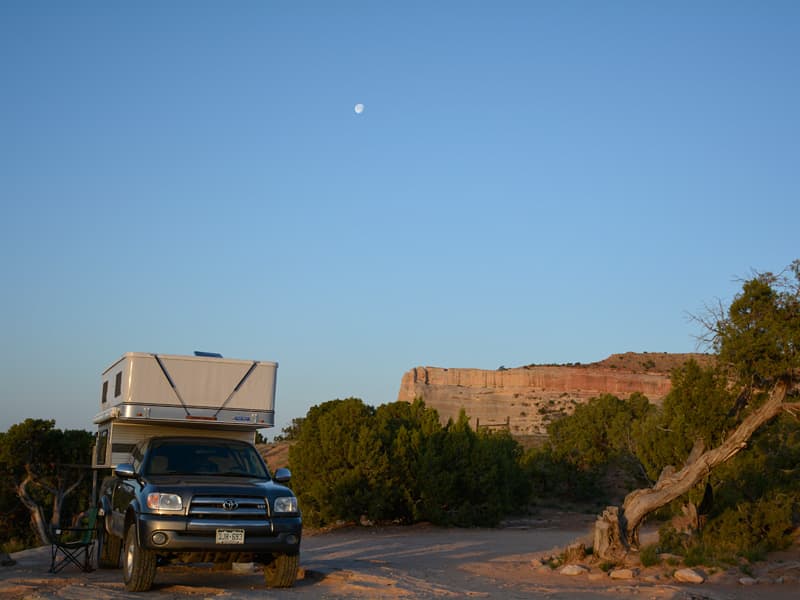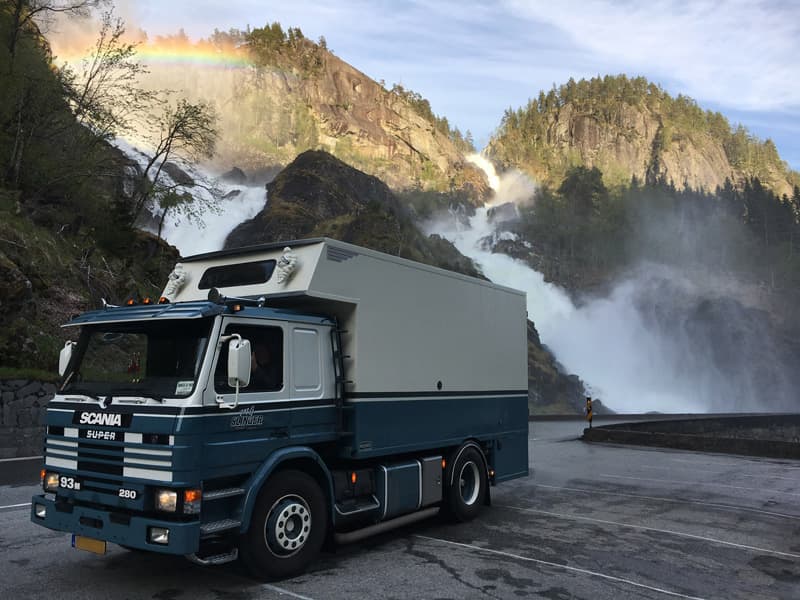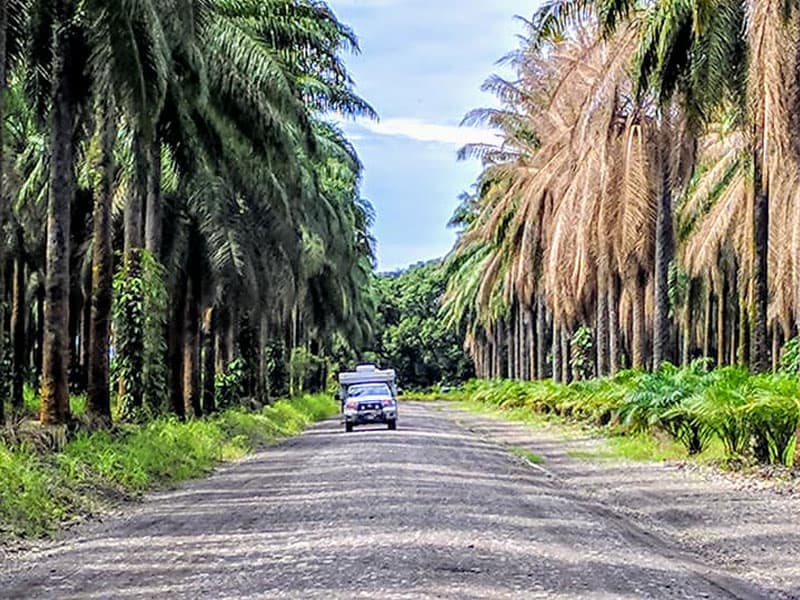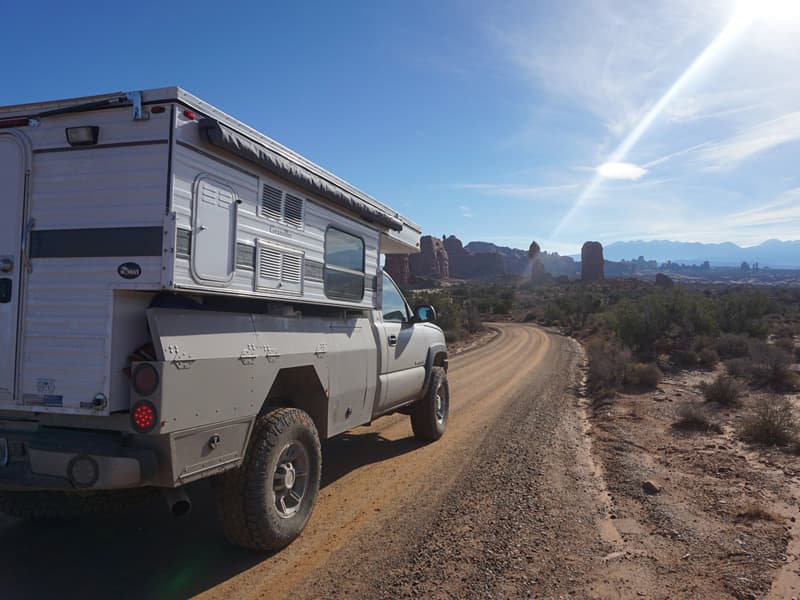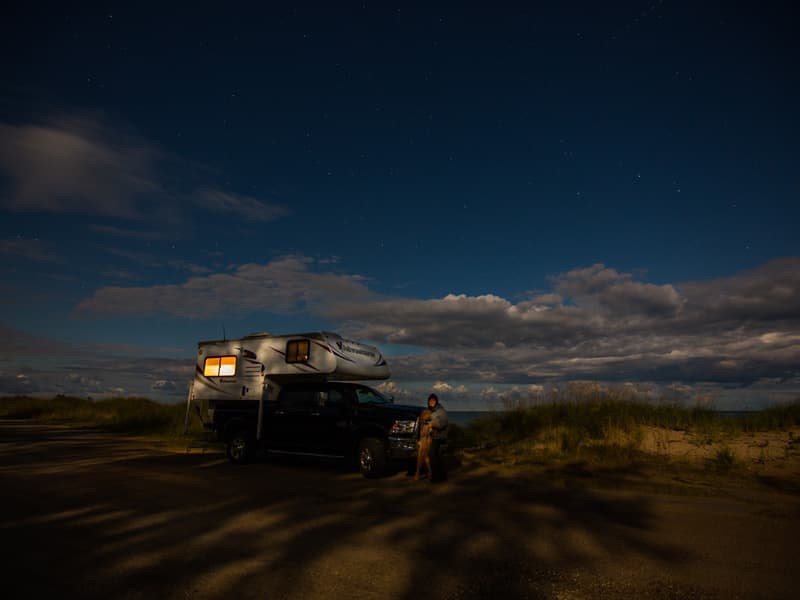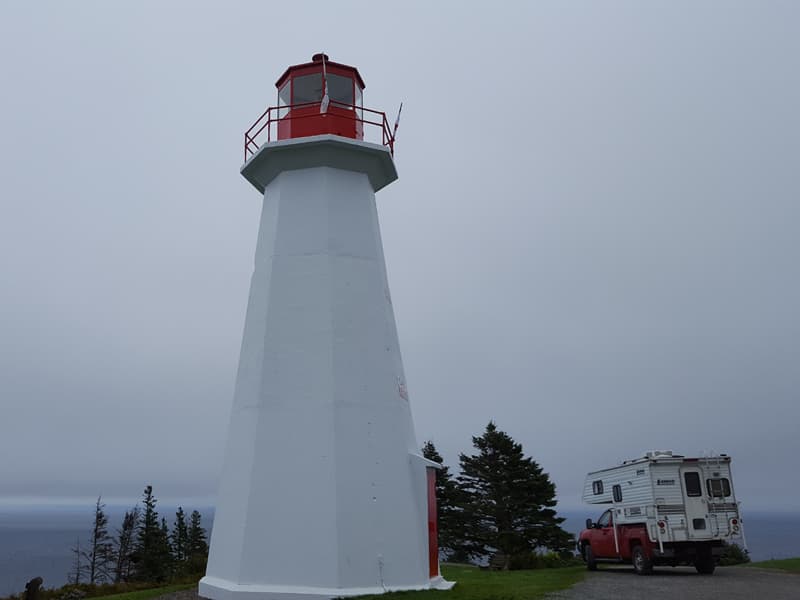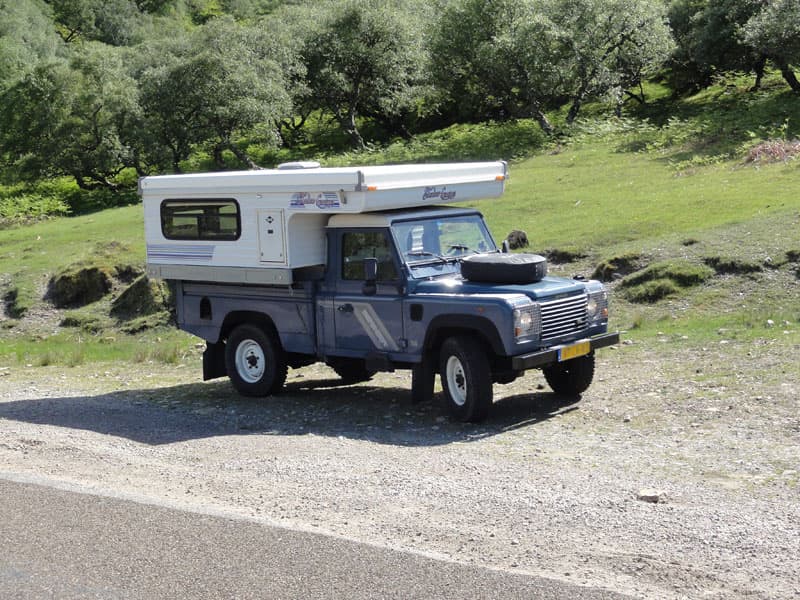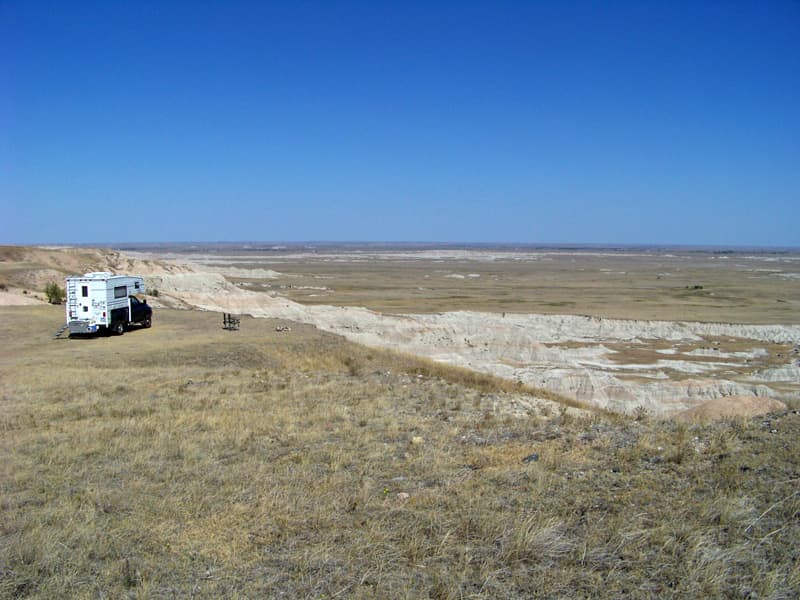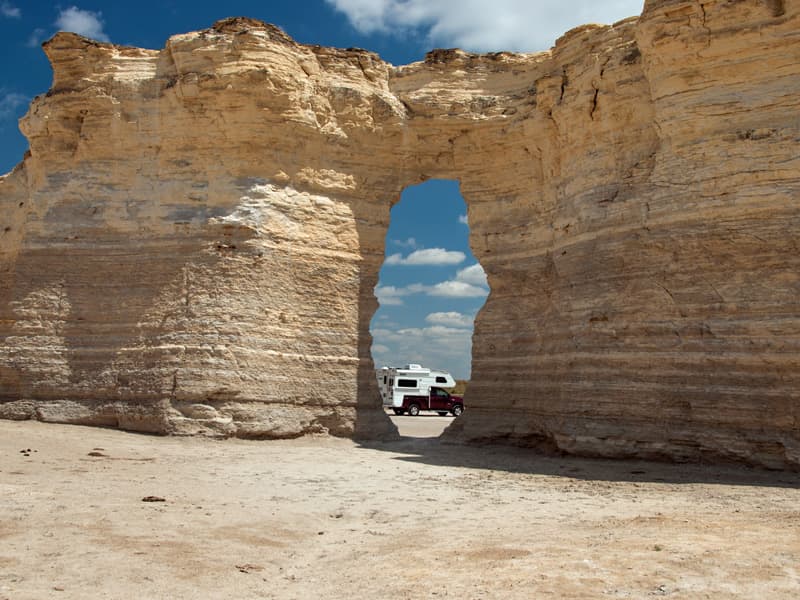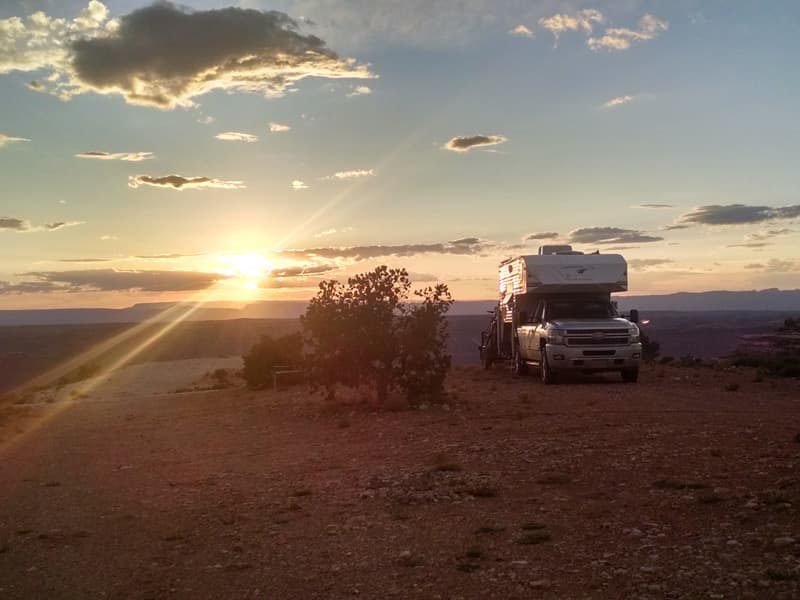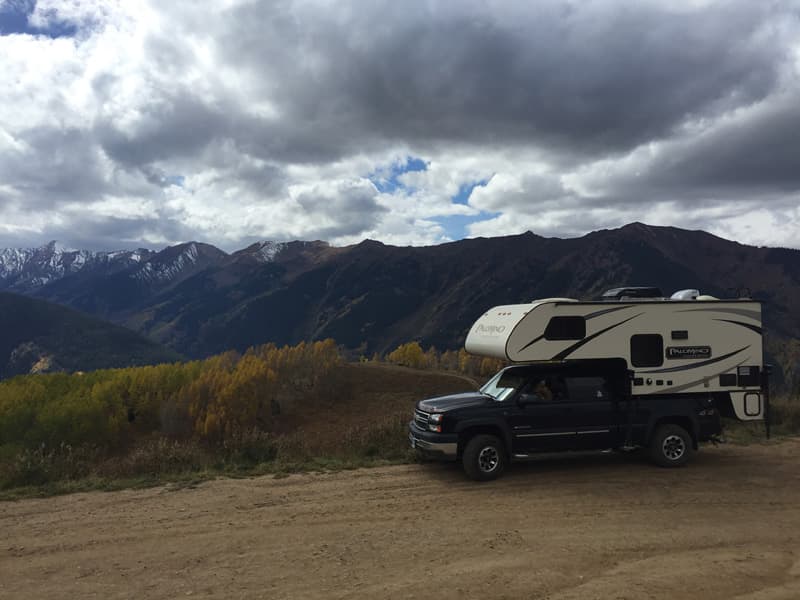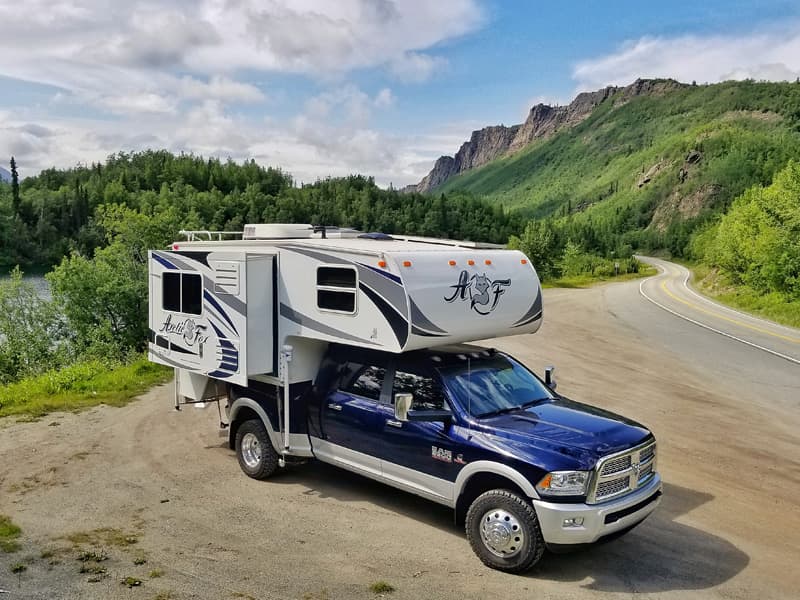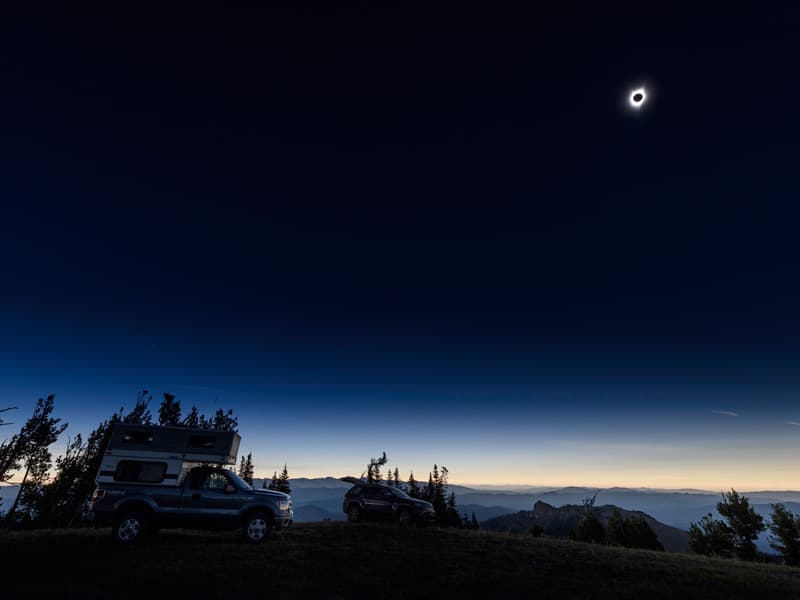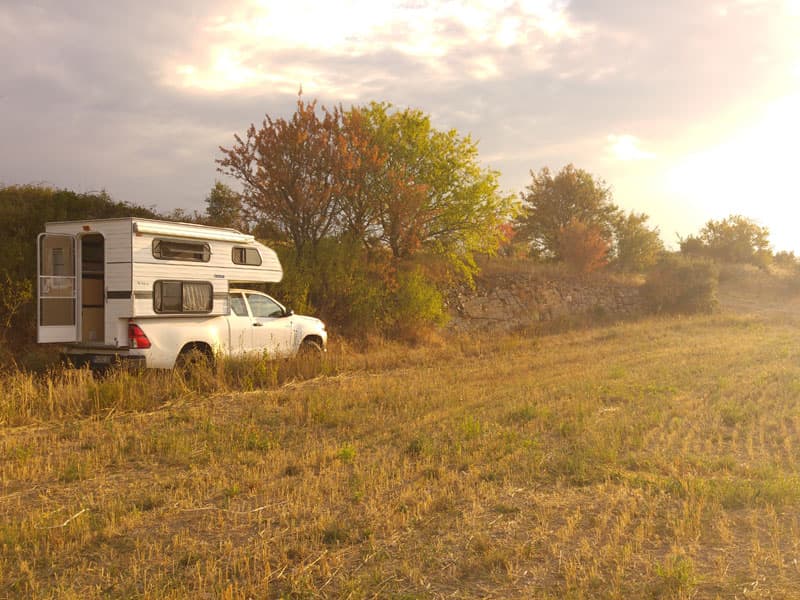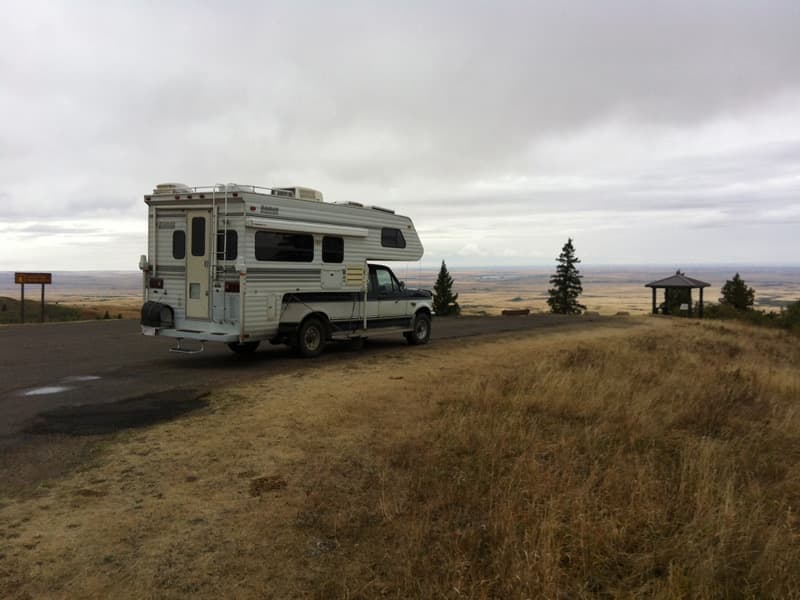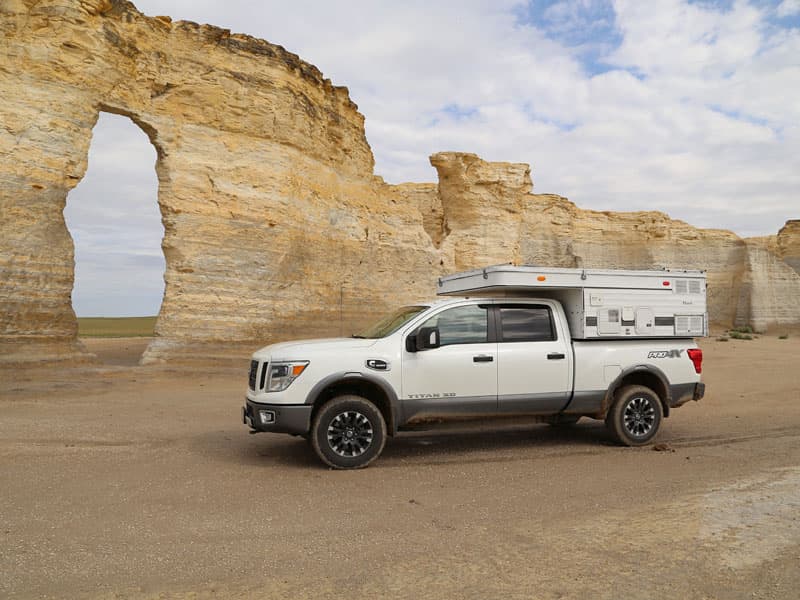After reviewing the reader responses to, “Rubber in a Can For Truck Campers”, the primary concerns are (1) trapping moisture and thus causing rot, (2) whether Rubber in a Can is the right material for the job, and (3) the need for long-term experience with the product and application with truck campers.
All of these concerns are 100-percent valid. We are particularly concerned about trapped moisture causing additional problems.
Taking a step back, our 13-year old project camper already had significant rot in the rear skirt. We needed to do something to repair and protect this area before a complete rear skirt rebuild would be necessary.
After careful consideration, removing the rotted wood and using Rubber in a Can seemed like the best solution to the problem. Line-X and similar professional bed liners were evaluated, but are significantly more expensive, not to mention much thicker and heavier than Rubber in a Can.
While I share the concern about trapped moisture, the Rubber in a Can isn’t a project without context. We have already properly caulked and sealed the roof and sidewalls stem to stern and regularly inspect and repair those seals. Nobody should apply Rubber in a Can to their camper underbody if they don’t regularly maintain their roof and side seals.
What our extensive work with sealants has taught us is that traditional RV sealant materials and techniques are inadequate. They take far too much time, and are too imperfect to be 100-percent relied upon. From this realization, it only makes sense to explore the diverse products and technologies of coatings. Consider Rubber in a Can our first foray into this universe.
Getting back to the reader concerns, we will be carefully monitoring our rear skirt for signs of water collection. We may even put weep holes in the material after significant rains to see if any water emerges. If we find a way to allow this area to breathe without compromising the rubber seal, we’ll try that.
We will report what happens. This is what pushing forward, conducting experiments, and having a project camper is all about.
This week’s Question of the Week was, “Does it make sense to coat the underside of our truck campers – especially the rear skirt and overhang areas – with Rubber in a Can sealant?”
“Rubber spray for overhang/skirt areas looks like a very viable solution, especially if there is no need to access the basement from below. Line-X would also work for this purpose.
The long term test will be if water finds ways of getting behind the coating and doing destructive deeds. Thanks for testing Rubber in a Can for truck campers and sharing your experience.” – Klaus Jager, 2014 Ford F350, 2007 Lance 1130
“First you have to understand what Rubber in a Can does. It protects from water ingestion in both directions. What a fence keeps out, it also keeps in.
The answer to your question is yes and no. Yes, if what you are trying to protect has the ability to breathe if it does ingest water. If not, then all you have done is to guarantee rot, not prevent it.
That does not mean this is all or nothing. You can still add Rubber in a Can protection if you have some weep holes or some way of allowing air to circulate and dry out if and when it does get wet or damp. Or if you can completely encapsulate the area 100-percent if it’s dry to begin with.
I did much the same with my truck camper and Rubber in a Can. But what I did not do was completely seal the bottom (which was plywood). I was cautious in my application to insure I did not seal so well as to prevent its ability to dry and that makes it a great idea!” – Don Pryor, 2017 Ford F350, 2008 Arctic Fox 1150
“I’ve used Rubber in a Can for the exterior of a skylight, and it worked. I’ve used it to seal a rain gutter, and it worked. I also used it to seal drywall hairline cracks prior to mudding and painting. The stuff works.
Though I don’t own a truck camper at this time, I have used Rubber in a Can on the underside of my travel trailer’s frame beneath the propane tanks. It’s been in place for months and appears to be holding up well.
Silicone has its place, but not on truck campers, trailers, or motorhomes. It is one of the worst sealants that exists for the job intended. There are many other products on the market that one would think RV manufacturers would rather use in regards to current sealant technology. They do not. It’s left to the owners to deal with it.
This was a good article. I think you’ll find that the sealant will work for years to come with minimal maintenance.” – Tony Valdivia, 1996 Ford F250 XLT, 2016 Cougar 29RK
“The last truck camper I had was a 1980 Edson 11-foot. I sprayed the bottom of that camper and the rear wings with a rust check rubberized under coating. I get it at Walmart for $3.45 a can. That was ten years ago.
When I sold the Edson this past spring it still looked like when I applied the coating. There were no soft spots or any fresh water stains inside the camper. The rear wings on the camper were as solid as they were ten years ago.
My newer camper has no rear wings, but the in-box parts will be undercoated before next summer. Without any reservations, it works.” – Brad Slatford, 2005 Ford F350, 2006 Westland 8.0
“I’m on the fence. I previously owned a Lance that developed wing rot issues but I feel it was more caused by the horizontal seam between the wing and the upper filon clad body than water intrusion from wheel spray.
My current unit also has wings, but they are one piece (something I expressly looked for) and underneath it is wrapped with a textured aluminum skin with exactly one well caulked seam. With regular maintenance, I don’t see the underside (which is also wrapped in aluminum skin) or the wings on this unit to be an issue.
When I bought this unit, I very carefully made sure there was a minimum of penetrations in the filon skin. More penetrations mean more places for water intrusion. This is especially true in the front nose area where, when driving in the rain, pressure is exerted and that causes water intrusion.” – Daryl Davis, 1997 Ford F350, 2015 Palomino SS1500
“My primary concern with coating the bottom of a truck camper would be water egress. No matter how hard you try, eventually water will get into your walls. Most owners aren’t as fastidious about sealing their roof and sides. Some points of water entry are a continuous issue. Once that water gets in, it needs to get out.
That said, I’ve coated several areas of my underside with undercoating, primarily the skirt.” – Brandon Smith, 2002 Chevrolet 2500HD, 1969 Avion C10
“A fantastically creative solution, and your typically well-written article. I really enjoy and respect your writing style.
The innovation facilitator in me wants to take a step back from your question and propose another. We won’t really know if it’s a good idea until some time and testing has passed. Instead of evaluating your solution specifically, we could go broader to the question: “What might be all of the ways to waterproof the underside and rear overhang of a truck camper and other exposed areas on the underside of RVs?”
I’m also thinking that we (you two and we readers) could share your article with any friends/clients we have who work in the industries making flexible spray-on polymers like body undercoating, rubber-in-a-can, Plastidip and other similar materials. Perhaps they can create and test a purpose-designed material to gain our market.
Those of you reading this, and willing to do so, please share the TCM article with anyone you know in these industries. I will share it with a couple of my clients. It would be fun to see that together, we catalyzed a nice advance in the truck camper manufacturing industry.” – Bob Eckert, 2017 Ford F350, 2015 Lance 825
“Sounds like this or some other flexible coating is a good idea. I will be very interested in seeing how the test turns out. Is this the best product? What is total cost? How long does the coating last? Does it remain flexible? If this is good idea, why aren’t RV firms or dealers already providing this service?” – Ed Albert, 2002 Chevy Silverado 250HD, 1995 Lance Legend 10-foot
“Hands down. Great idea!” – Dan Walinsky, 2015 Arctic Fox 990
“Thanks again for a great read. I’d never given it a thought, but now that you have let me in on it, I’m gonna get right to it!” – Bill Strickland, 1996 Ford F250, 1999 Lance 845
“Great timing on this story as I’m currently in the middle of resealing our camper and haven’t gotten to the bottom yet. The question I have is, “What’s the base material in Rubber in a Can?”
After spending hours cleaning silicone based sealants off of fiberglass and aluminum, (and cursing whoever used that stuff on a camper), I want to know what I’m applying before it goes on.
Not being a chemist, I’ll be looking on Google and trying a can before I apply any to the camper. If it’s not silicone based, it looks like a great way to address a real problem.” – Harry Woodworth, 2001 Dodge 3500, 2000 Snowbird 8-10
“Absolutely, if it’s done correctly and if it’s done only on seams or areas that have the potential to take on water migration through a crack or seam.” – Curtis Gray, 2017 Ford F350, 2017 Arctic Fox 990
“I used it and had a real problem with it trapping moisture and then delaminating. I finally spent six weeks of my spare time descaling the frame and treating it with POR-15. This was a bed off and front end off task. I also replaced the rockers.
A year later I had the entire frame and underside sandblasted and treated with a mil-spec, asphalt-based undercoating. In short, the rubberized stuff only makes things worse if you live where they use heavy salt on the roads.” – Tobin Koch, 2003 Sierra 2500HD, 2007 Lance 845
“I like the idea of sealing up the underside of the camper after replacing the rotted out areas. I had to do a similar repair but instead of using a spray can undercoating product, I used a two part epoxy urethane bed liner product. It had to be brushed and rolled on. It was a little messier, but much longer lasting.” – Jeff Hauser, 1996 Dodge d2500, 2007 Arctic Fox 680
“I’m very wary of spray-on undercoatings which were very popular in the 1970s and 1980s. When it failed, it was virtually impossible to remove and – if you re-coat over it – you must take into account the additional weight of each case of re-spray.
Additionally, when the initial coat fails, the voids accelerate additional rust and rot by encapsulating moisture. I would think twice before selecting this alleged easy fix choice.” – Bob Shaffer, 2016 Ram, 2016 Four Wheel Camper Hawk
“It looks like a great idea. That area gets a lot of overspray and rocks. I put an undercoat on my Adventurer. If I were going to do it again I would use the spray-on rubber coating.” – Ron Wolfgram, 2000 Ford F250, 2006 Adventurer 810WS
“Good idea. My Palomino SS-1240 is made for a short or long bed with access doors on each side for short bed use. All that was needed was to add enclosures on both sides. When I added the enclosures, I coated the outer part with two coats of black Flex Seal. It matches the color of the Palomino’s underbody.” – Joe Tamulevicius, 2017 Chevy Silverado 2500HD, 2016 Palomino SS-1240 Backpack
“It sounds like a great idea for a new camper but I would be concerned about it sealing in water, dampness, or some other problem on an older camper.” – Tony Sutton, Isuzu D-Max 2017, 2004 Northstar 700DL
“What about Flex Seal? It looks good on their television advertisement.” – Charles Bradshaw, 2016 GMC, No camper yet
“Thanks for sharing this complete process. I can see significant deterioration on my rear skirt. I was thinking of trying to rubber coat it this winter. I will definitely use this process on my Northstar.” – Robert and Cathy Fournier, 2013 Silverado 3500 HD, 2014 Northstar Igloo 9.5
“I think it is a great idea. I was going to do mine with Por-15 bedliner because I used it to undercoat my Chevelle. The rubber would flex and not crack.” – Marc Cuslidge, 2006 Chevy 2500, 1994 Weekender 1010
“My Lance 815 had a dump valve recessed box cutout in the overhang that was not protected with any coating at all. On my first trip with rain, I noticed the valve area was wet from tire spray. I immediately applied a spray-on rubber coating and eliminated any potential problems. Sorry, I can’t remember the product used, but there are lots of products out there.” – Jesse Taylor, 2005 GMC 2500, In between campers right now
“Well duh! Anything that helps prevent wood rot and water leaks has got to be good. Will Rubber in a Can do this? I think so! This has been on my list of things to do. You pushed me along a little.” – Denver Woods, 1997 Ford F350, 2001 Lance 1121
“Little late on this article. I’ve been using a spray undercoat for years on many of my toys. Rubber is nice, but I wonder how long before it starts degrading. The undercoat is a petroleum based spray that comes out as a tar. It’s easy to shoot, not expensive, and it fills in everything.” – Michael Shea, 2016 GMC 2500, 2006 Palomino camper
“Yes, I have been planning on this myself but haven’t decided yet what material to use. Rubber in a Can, spray can bed liner, etc. I plan on doing this in the next two or three weeks. I have been leaning towards the spray can bed liner as I feel it will hold up better to being in the bed and rubbing on the floor or occasionally sliding across or down the wheel wells.” – Kevin Jenckes, 1996 Ford F250, 2005 Lance 820
“I think it should be done at the factory.” – Robert Burlin, 2010 Ford F150, 2013 Lance 825
“Good idea. I’ve been thinking of doing this with Thompson Water Seal to the bottom of my camper. I might use the rubber sealant instead.” – Chris Jeffery, 2017 Tundra, 2017 Travel Lite 625
“Sounds like a great idea! A factory option for something like this would be very welcome.” – Mark Joslin, 2006 Ram 3500, Searching for a camper
“Great idea! Don’t hold your breath waiting for the manufacturers to implement this idea. Having a twenty year lifespan on a truck camper would put the industry out of business. How is it holding up?” – Marty Commins, 2007 Ford F250, Nash 22GQ Travel Trailer
“Seeing the Rubber in a Can, it almost looks like a product I use on the lower part of vehicles in a larger can. I can re-use it by removing the turn off cap, and inserting my Air Connection Shultz Gun as it leaves a nice finish and seals.
Also, I noticed in one publication that a trailer manufacturing company was building their camper shell out of plain 2x4s. Why not use pressure treated lumber as it’s coated and lasts a lot longer?” – Brian T. Seguin, 2008 Ford Ranger Sport, N/A
“Great idea. Anything to deal out moisture.” – Bob Brown, 1974 Ford F100, Steel stream shell
“I think it’s a great idea. My Palomino is Line- X coated from the factory.” – William Steger, 2005 GMC 2500HD, 2016 Palomino HS-2902
“It would be nice for truck camper manufacturers to use Rubber in a Can or some other long lasting protectant. We had rot on our old Lance camper. Now we wipe down our rear skirt and overhang after we have driven in the rain.” – Angela Klinger, 2004 Dodge 3500, 2017 Arctic Fox 1140
“I think the rubber coating might be too soft and I would rather see a spray on truck bed liner like Rhino Liner. That would be very durable and water tight.” – Gerald Kato, 2012 GMC 2500, 2017 Cirrus 820
“Yes indeed, 10-4. I spent over $1,000 repairing my 18-inch overhang when my truck camper was only three years old. I truly believe any quality coating would have saved me from a serious costly repair and down time on scheduled travels. Unfortunately, I had large void openings that no sealer could have sealed.
No question that a quality sealer is a fantastic idea for the manufacturers, but the industry should set the standards for the product. All warranties should be extended in that category far more than one year as it will likely take longer to rot.” – Bob Robinson, 2002 Chevy 2500, 2010 Travel Lite 960RX
“I am more interested in the rubber as sound proofing for the truck’s cabin and maybe stone protection. I wonder if it’s suited for inside the doors, under the cab, mud guards, and the inside floor of the cab? Anyone know how long it should last, what it’s based on, and if the fumes are toxic?” – Jason Firmstone, Unimog, TBA
“I say, hell yes! I’d be interested to know perhaps from Mikeee how the coating prolonged his Proflex sealed seams? Is he finding that they don’t need to be redone as often – or at all? I would also like to know how resealing goes if it does need to be done.” – Nik Rende, 2011 Ram 3500, 2001 Lance 1121
“Great article. You made me look like a movie star. Seriously, you have brought up some great questions and I am very interested in what they will be like.
I had my Lance off my truck just after you left and found three small areas that needed to be touched up; small cracks to be precise. I whipped out another can of Rubber in a Can and voila, all is good.
I check the rubber again during my six-month check up.” – Mikeee Tassinari, 2002 Ford 350, 2016 Lance 1172
“Excellent idea and this would have saved me from a lot of work. You can be sure that I will be coating a good many of my surfaces with this or a similar product.
I have already used the Flex Seal product advertised on television in white to match my camper and it looks and works great so far. I went over all the joints and wall seams with it after a thorough cleaning and it has worked out really well, so far.
I have driven 2,400 miles. I will be monitoring for long-term durability and performance, but it seems to be the aspirin for stopping nasty headaches down the road.” – Rob Riley, 2000 Ford F350, 2005 Palomino Maverick
“There are a lot of roofs in Florida staying waterproof using Rubber in a Can until the reputable roofers can make permanent repairs. I haven’t heard of any complaints yet. Now comes the ultimate question, “How would this work on the rubber membrane of an RV roof?” It would be great not to have to check roof seals every few months.” – Gary Usher, 2017 Ford F350, 2015 Lance 1172
“I like the idea of sealing the bottom of the camper. This is a problem that I have with the amount of overhang on my camper. Going on some of the back roads or dirt, the amount of filth that gets slung up there is amazing. I clean mine every time I go back to Pennsylvania.
I would tell anyone going to Alaska and/or Canada to get the best mud flaps you can buy. The dirt and oil they use on the roads is extremely hard to remove.” – Jesse Black, 2015 Chevy Silverado 3500, 2010 Lance 1055
“Rubber in a Can sounds like a good idea. I was shocked this summer to find my rear skirt with rotted wood. It lived most of its life inside and was used very little before I bought it. It appeared sealed, but obviously wasn’t. I hear great things about the Rubber in a Can so, in addition to the normal seam sealing, it may be cheap insurance.
I’d like to see Lance use a composite wood product in that area. For a few bucks more in material, you could have drain holes and never have to worry about it. It appears to be a weak design area.” – Bill Klein, 2007 Ram 3500, 2009 Lance 915
“The sealant on the underside is a good idea, especially if the exterior surfaces are wood and are not properly sealed and open to road spray. Raw wood will take on water and rot if it cannot dry. The underneath sides of RVs do not get the attention they need in that respect. Because of this and the fact that it is harder to inspect, the underside is where problems are the often the worst.
Regardless of what you use to seal underneath or up on the roof, the product needs to be compatible with what you are applying it to and the surfaces need to be properly cleaned and prepped.
The different roofing membranes require specific sealants to be used. Without cleaning and prep they will not bond correctly. These sealants, regardless of where they are used and applied, must be tooled on using a finger or soft tool to force them into the opening and bond.
Do not trap the water! If water is getting in, it must be stopped or at least allowed to get out and dry. Some things are designed to release the water, so do not plug it up. I have resealed the roof on my unit and the underneath side that catches the road spray. I was careful not to create a place for water to enter or to be trapped.” – Geep Moore, Ford F350, 2007 Hallmark Cuchara
“Waterproof coatings seal water out and any moisture in the wood in. If moisture gets into that wood from inside the camper or a bad seal above, it will not be able to dry out.” – Jim Norman, 2001 Dodge Ram 2500, 2011 Four Wheel Camper Grandby
“I don’t own a camper yet, but one thing I would be concerned with is the rubber sealant potentially trapping any moisture that settles in the frame from above, thereby encouraging rot and mildew. If moisture gets in, it needs to have a way to get out as well.” – Tom Bierschenk
“With our 100-percent aluminum and composite Camp Lite, there is no wood, no rot, no steel, and no rust.” – Mark McVicker, 2005 Ford F250, 2014 Camp Lite 11
“It seems to be a good idea. Mine doesn’t have a lot of overhang but it has needed work.” – Mike Chesnutt, 2010 Toyota Tundra, 1995 Hide Away 855
“I think it’s probably a good idea if the surface can receive proper preparation.
There are other very similar products that are applied with a brush or roller. A brush or roller would typically leave a much thicker coating than an aerosol spray can. This would, “seamingly” (that’s payback for some of Gordon’s editorial wordplay!) have a better chance for success.” – Bruce Allison, 2017 Ram 3500, 2012 Adventurer 910 FBS
“I coated ours with Flex Seal several years ago. It has been working very well.
While repairing water damaged material underneath, I called Northwood to find out what would be a good choice for the repair. I don’t remember who I spoke to, but I was told that Rustoleum truck bed coating was very similar to what was on the plywood they purchased.
I didn’t find the truck bed coating locally, but did find Flex Seal in both black and clear. We coated the plywood cover material both inside and out. The clear was used on trim screws and anything else that wasn’t originally black. The odor was not an issue even with the inside basement floor sprayed with the material.
It has been several years now and we’ve had no issues.” – Joseph Garrett, 2008 Chevrolet, 2005 Arctic Fox 990
“Great idea. The product should work well on a well prepped surface like you have done. My Palomino 8801 is painted black in all those areas. If it ever needs attention, the black rubber will blend right in.” – Larry Kelly, 2017 Ford F350, 2015 Palomino Backpack Edition 8801
“I absolutely agree with using a rubber coating on the rear skirt and overhang! I have a similar situation with my truck camper, but the outside aluminum skin has started to corrode. Aluminum does rust. Road salt will eat and slowly break it down from the unpainted backside. My repair will be more complicated but Rubber in a Can will help seal the rear skirt and overhang. That’s next spring’s project.” – Lucien Langlois, 2012 Ford F250, 2004 Lance 1025
“Great idea. Anything that helps protect our camper from leaks or damage, we consider a good thing. Someone should start a business doing this.” – Rhonda Saul, 2004 Ford F350, 2008 Arctic Fox 990
“I think you need to be careful about making any living space air tight. Rubber reduces the ability of the camper to breathe, a needed process when humans live in tight quarters. Moisture trapped on the inside always needs to find a way out. Spot coatings can be a benefit when selected with care.
Remember water follows gravity. Even vapor creates droplets that seek exit of the dwelling structure. Wood rots only when it can’t dry out.
When it’s maintained properly by being sanded, painted, and finished on a regular maintained schedule, it will hold up for years. The bottom coating with rubber is like putting a baggy over the wood. I am talking about covering wood, not metal parts. Let the camper breathe.” – Micheal Hook, 1990 Ford F250, 2004 Lance 1190
“As long as the bonding is good, all will be well. If the bonding starts to let go, bubbles or space to hold dirt and water will form and decay. Wood failure will happen faster than with no coating. One will need to watch for this.
I have used asphalt shingle cement for the same type of job for 20 or 30 years. After cleaning the surface of dirt, I apply cement with a short haired paint brush. It saves all the masking, hazards, and mess of spraying. It can also work cement into cracks and surface imperfections better than sparing.
If the bond lets go, scape it off with a putty knife, clean and reapply. I have had very little trouble with the bond letting go. There seems to be about a five to ten year life to the bond.” – John Hallett, 2011 Dodge 3500, 2014 Bigfoot 9.6 LB
“I have seriously considered using some product on the overhang of my camper for about a year now. The coating is beginning to peel off and something needs to be done. Now that I see what you have done I will be doing the same within the next month. Thanks for providing a great tutorial.” – Ralph Bunn, 2015 GMC Sierra, 2004 Four Wheel Camper
“If it’s anything like a sprayed-on truck bed coating, it will be a huge improvement. But then almost anything is an improvement over the paper coating on my Lance.” – Kenneth Hufnagel, 2005 GMC 2500HD, 1998 Lance 845
“Very good idea. I use 3M Window weld sealer. It’s what they use to glue in windshields and it’s a good under coating. I have even used it for temporary repairs on fuel tanks and oil pans. Make sure to use gloves. It sticks like glue.” – Bill Harrington, 2004 Ford F350, 1997 K-Z Sportman
“Initially, it sounds like an awesome idea. I do agree this part of our truck camper is probably the most neglected. The ole, out of sight, out of mind applies here.
What I am really looking forward to is how you feel about Rubber in a Can a couple of years from now. Did it actually block water, or did it allow the moisture to be captured under the rubber?
Hopefully, it protects, and if so, I will be all over getting Rubber in a Can – in a heartbeat.” – Gary and Cinda Whistler, 2013 Silverado 3500, 2017 Lance 1172
“It’s true that I have no experience with the rattle can rubber, but having just returned to northern Michigan from three months traveling all over Alaska, the Line-X coating on my Palomino SS-550 is still like brand new. It is 100-percent water, moisture, and air tight. Amazing.
Perhaps like a lot of stuff, you sort of get what you pay for, but personally I’m sold on Line-X. If I had a significant rear overhang, I’d go the Line-X route.” – Shellie Barnes, 2017 Ford F250, 2017 Palomino SS550
“A few years back I had to rebuild parts of my camper. I rebuilt the two sides that go horizontal over the rails of the truck. I used furniture grade 1/2-inch plywood sandwiched together to create 1-inch thick material and coated it with marine varnish. After installing it, I coated everything that sits in the truck up to the sides above the rails in truck bed liner.
I take the camper to Island Beach State Park in the spring and fall for weekend fishing and camping on the beach. I know a few other people that have used truck bed liner to coat the same areas. There is one guy I camp with who did the whole camper in it. No more caulking, waxing, applying rubber roof protector on it, etc.
The rubber is a good idea. I looked into doing it with undercoating spray and felt the truck bed liner was more of a sealer and added more protection.” – John Staiger, 2008 Ford F350, 2002 Elkhorn 11x
“After reading about Harley’s undercoating job, I went out this morning, raised the camper and had a look. While dirty, it was visually obvious where the rear wheel back spray was the most adverse.
Gravel, sand, and water had impacted a fairly narrow area of the camper’s rear bumper. Of course I mean the front of the rear bumper, exposed on the camper’s underside and directly behind the single rear wheels of my truck.
The underside paint was dinged and rough from lots of road kick-back. The wings (skirts) were dirty and were exposed to splash water, but the joints were well sealed, tight, and undamaged.
A complete liquid rubber re-coat would involve spraying over wiring routing ports to the rear and side running lights. Also, the sewer hose storage compartment in the bumper is not sealed (by design) so that water in that compartment can drain and dry out. I did not want to spray closed any of those drain holes nor any intentionally open assembly joints. There are several structural bolts/nuts in the area that I was reluctant to seal inside liquid rubber.
Finally, based upon experience with a previous camper’s shower drain, I considered what would happen with a plumbing leak inside the camper, where a tightly sealed rubber coating would keep such a leak contained inside the structure and resist any natural dry out process.
I decided to use a liquid rubber product, but limited the application only to the relatively small areas directly behind the rear tires. I took the opportunity to completely clean the entire overhang under the camper, then sprayed the rubber coating only on the metal bumper in the areas damaged by gravel kick-back. This area is not visible unless you are under the camper.
This sealed the damaged pock-marked paint where it was chipped, and left a softer impact surface resistant to road debris. I’ll re-spray as required every year or so.
Thanks for sharing your experience with liquid rubber. I hope you will occasionally share good or bad lessons learned over time.” – Gary Possert, 1998 GMC K3500, 2014 Lance 1050s
“After having owned truck campers for many, many years, we’re hoping with the Northern Lite we’re beyond this issue. I don’t have any experience with Rubber in a Can, but a fair amount with the rubberized bed liners on the market. I do like the Rubber in a Can concept and very interested in a long term results.
That being said, the bed liner materials would have likely taken more time to put on and the process might be a little different, but I think I would be happier with a thicker coating than out of a spray can. The additional weight of a very few pounds wouldn’t matter to me in the slightest, but a more robust layer certainly appeals to me. But, time will tell.” – Pete Clark, 2017 Ram 5500, 2017 Northern Lite 10-2 SE
“It looks like you folks did everything needed for prepping the surface and did a nice job of applying the product. That said I would agree that time will tell on the durability. Keep us informed.
Also, I would wonder about an automotive undercoat that is available in a can or sprayed by a dealer. Is it similar or different enough in design to be more durable? I don’t know. Nice job on the work.” – Dean Rognrud, 2017 Ram 3500, 2017 Adventurer 86SBS
“I think it is definitely a good idea! Anything you can do to keep moisture out is a good thing!” – Tom Miner, 2004 Dodge Ram 3500, 2005 Host Yukon 11.5 SS
“Sounds like an excellent idea. I have spent a few hours sealing and caulking our roof and exterior. I am liking the idea of sealing the underside and skirt area.” – James Schaaf, 2014 Ford F-150, 1999 Northstar
“I am not a mud flap lover. I don’t care for the way they look on the truck so I never installed them. However, I have been looking for the least getting some kind of protection for the rear skirt area of the camper.
The large area that overhangs on my unit is starting to show some dings and dents from the road debris. I never thought about actually spraying it before. What a great idea!
The color would have to be white for me otherwise it won’t look right in my opinion. I know that you can buy a rubberized coating in white because I rolled it on a porch roof. It is very flexible and a second coat should give it adequate thickness.” – Paul Matthews, 2015 Dodge 3500, 2012 Lance 1191
“Partly a good idea. If there is a water leak it may not allow drainage and then more contained rot and undesirable growth. Also finding a leak may be more difficult.” – Roy Garland
“Sounds great! I would have loved to try it on our last camper, an Arctic Fox.” – Bob Knepper, 2017 Dodge 3500, camper-less right now
“Excellent idea!” – Michael Aherin, 1997 Chevy Silverado, 1986 Viking
“I think it should be offered as an option from the manufacturer.” – Sidd McDonald, 2018 Chevy, 2018 Adventurer 89 RB
The post Rubber in a Can For Campers: The Verdict Is Sealed appeared first on Truck Camper Magazine.
